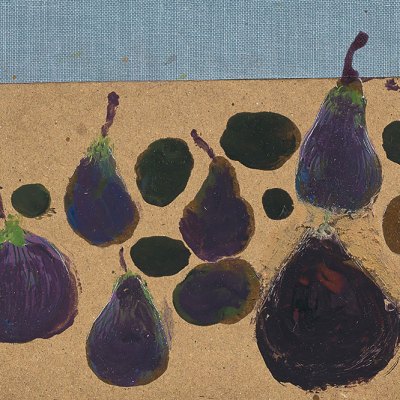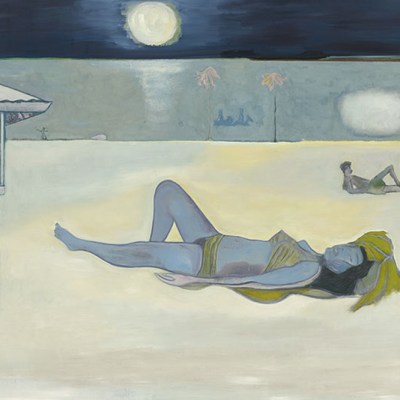From the November 2023 issue of Apollo. Preview and subscribe here.
Andrew Cranston’s studio is no one’s idea of a minimalist dream. Located in a block of studios in the west of Glasgow – all newly polished ex-warehouses and neon logos – the single room has a vast window at treetop height that lets in a cool, steady light even on a grey day in late September. One wall of it is lined with bookshelves, the others are covered in works in varying degrees of completion – Cranston needs to live with a painting before he knows if it is asking for more attention, he says – but there is a lot of stuff. He insists that it has just been tidied up and while it’s not the messiest room I’ve ever been to, it still feels as though it is overflowing – with art books, equipment, relics from his past, a tricycle and even a toy sheep.
This seems fitting, in a way. Cranston is an artist whose canvases contain worlds. He layers up scenes with so many details, the clutter of real life, that it is hard to believe they are works of imagination. The trick is they might not be. They hover in a space between the real and the unreal and change shape as they flit between the two. Scenes are recapitulated in different colours and take on different tones. He’s very good at mining the tension within these differences for an unnerving effect, even when the works are not together. Partly because of this, he has developed a devoted following, though the numbers of his followers might not be huge. That might change when his new exhibition, ‘Andrew Cranston: What made you stop here?’, opens at the Hepworth Wakefield this month (25 November–2 June 2024).
The artist’s studio, with works in varying states of completeness displayed on the wall. Photo: Matthew Arthur Williams
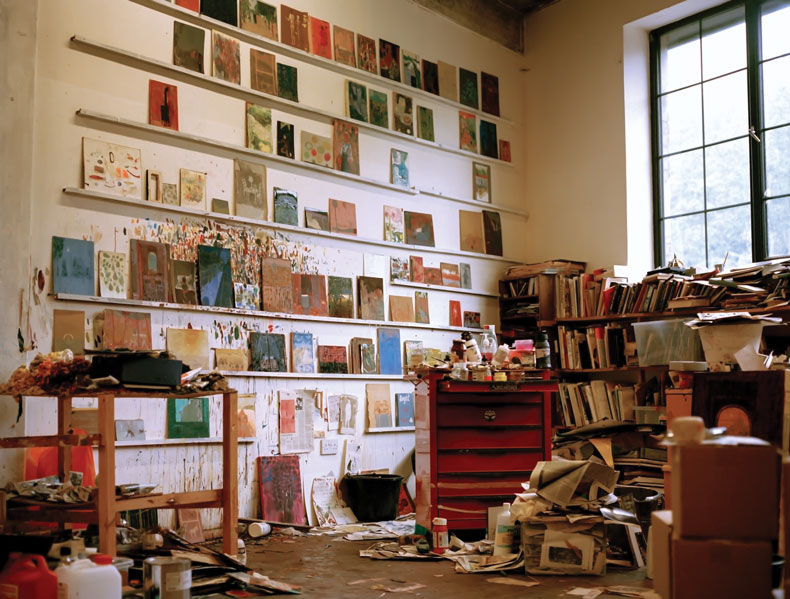
Cranston trained at Gray’s School of Art in Aberdeen before doing an MA in painting at the Royal College of Art; for the past 25 years he has been painting scenes of wry humour and subtle horror in a style that, while clearly related to the Post-Impressionists, has become entirely his own. Oil paint – and more recently tempera – is layered to create an image of the world that in some works feels like a reinvention of pointillism, while in others loose, playful strokes are much more suggestive of easy pleasure. While these works caught the attention of galleries such as Ingleby in Edinburgh and Karma in New York, Cranston remained overlooked both by institutions and by the wider art-world establishment. His largest exhibition to date, ‘But the dream had no sound’, was at the Ingleby Gallery in 2018. It was as though the art-world gatekeepers misread the delicacy of his work as evidence of an interest in pattern and surface, rather than of its real wit and seriousness. As important collectors become more interested in his work, however, it seems as though that tide might finally be turning.
The exhibition at the Hepworth Wakefield is based on a group of paintings that were seen at another Ingleby exhibition over the summer, which was called ‘Never a joiner’. Cranston describes himself as ‘tickled pink’ about the museum show. ‘I kind of thought museum shows were getting a bit tricky for me to get,’ he says, with typical self-effacement.
Cranston is perhaps best known for his works painted on books. His still lifes or people or even rooms and houses come to life on a hardback cover – the decoration of the book cover offering a reassuring invitation to paint, at least a colour to start from. ‘There’s a starting point rather than just a blank white canvas,’ he has said. As he explained to his friend and former teacher Peter Doig in an interview, this habit of painting book covers arose simply out of necessity: ‘I’d run out of things to paint on.’ It’s a surprise, after these diminutive works, to see a series of canvases on a large scale: the works that were in ‘Never a joiner’ are around two metres by two metres (though rarely square) rather than the 20cm-wide book covers of previous exhibitions. In fact, Cranston is clear that he has ‘always made bigger paintings’, although ‘there were a couple of years where the emphasis was on smaller work.’ By way of explanation, Cranston conjures an image that seems to have floated up from one of his works: ‘It’s a bit like a goldfish expanding into a pond,’ he says. ‘Sometimes I’ve had really small spaces to work in so practically it’s been quite tricky at times.’
Why have you stopped here? (2023), Andrew Cranston. Private collection. Photo: John McKenzie; courtesy Andrew Cranston and Ingleby, Edinburgh; © the artist

In works such as Why have you stopped here? (2023), Room that echoes (2021) or Vague feelings of dread (2022), goldfish seem to appear quite frequently. It might seem that goldfish are a preoccupation of Cranston’s, but he is clear that this is part of a wider interest: ‘Animals in general’ are what he describes as the focus of his work (which is not to say that human and vegetable subjects are omitted). Paintings of animals are, according to Cranston, ‘in the same territory as figuration,’ but ‘maybe loaded differently than a person figure.’ Animals offer ‘a sense of entity and of empathy and some human characteristics but I think it’s like another point of view, in a way.’
Certain animals, it seems, come with their own energy and Cranston brings to his depictions of animals the attentiveness of a painter, not a pet owner. He has previously mentioned the pet monkey called Cookham (nothing to do with Stanley Spencer, he assures me) that his father had as a child, but his own childhood home in Hawick, in the Scottish Borders, was pet-free. Cats – which also make fairly frequent appearances in his work – were ‘seen as the enemy’ by his gardener father. In the book accompanying ‘Never a Joiner’ he writes: ‘I prefer dogs but cats are more mysterious.’ In person, he admits that ‘I don’t mind cats.’ Eventually, and with some reluctance, he goes so far as to admit that he likes them.
Cat and cheeseboard (2018), Andrew Cranston. Private collection. Courtesy Andrew Cranston and Ingleby, Edinburgh; © the artist
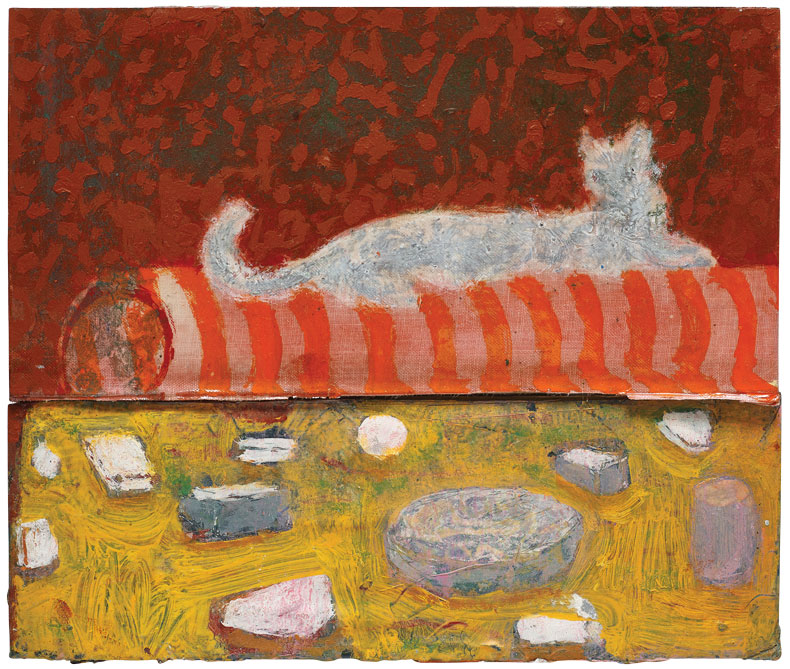
A domestic pet offers, he says, ‘a sort of added homeliness’, but also comes with its own other attractions. ‘I’m fascinated by the incongruity of humans and animals in shared spaces,’ he says. In an unexpected turn, ‘Tortoises have turned up quite a lot as an animal that I’ve painted and for various, slightly kind of comical reasons.’ The reasons are to do with surprisingly human concerns: ‘Painters being a bit like tortoises, in it for the long haul, rather than this other sprint. And they hide away, and they’ve got a different sense of time, haven’t they, tortoises? But there’s this sort of hardiness to them and of course there’s a slight strangeness to them.’ The strangeness includes, for Cranston, outliving the families to which they belong, but also ‘the shape of them, their abstraction if you like’. For the artist, life and painting seem to intersect so often that they become indistinguishable: ‘There’s all sorts of driving factors within a painting,’ he says, ‘and, of course, the kind of visual shapes and forms that you’re playing with could be an initial, actual impulse, but then you’re kind of also interested in what its status says within the world’ – and so the tortoise crawls into his canvases, his newly imagined world.
The beautiful south (2019), Andrew Cranston. Private collection. Courtesy Andrew Cranston and Ingleby, Edinburgh; © the artist
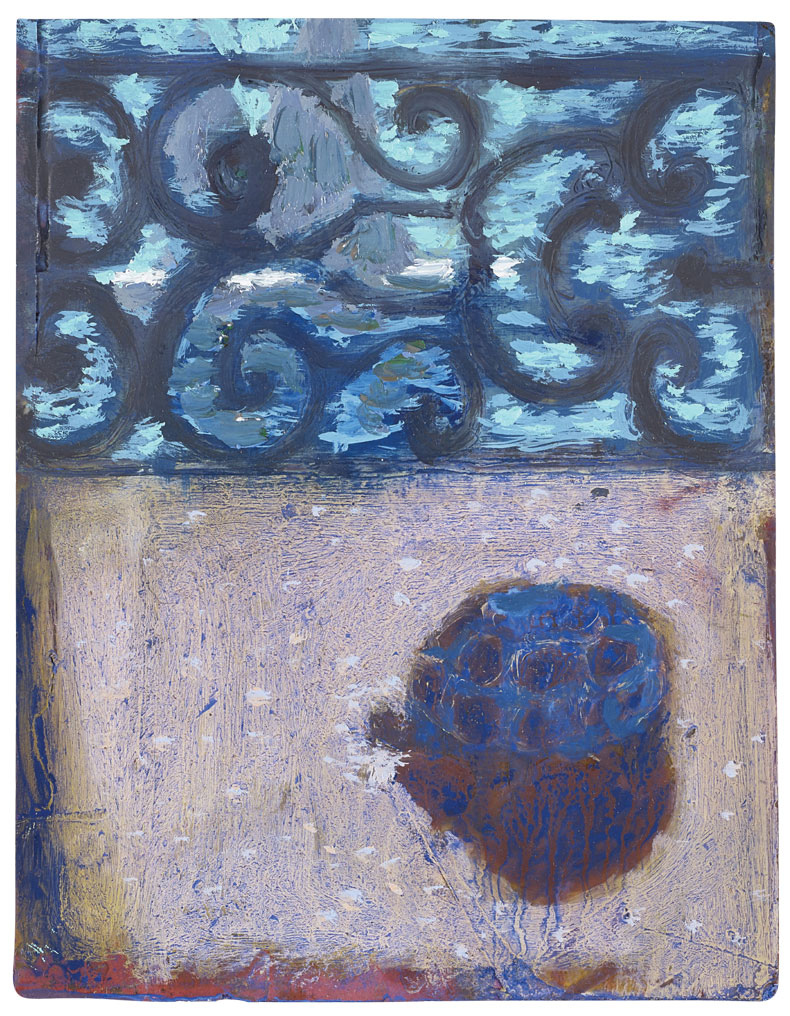
The strangeness of animals in the human world sometimes tips over into something more sinister. In A snake came to my coffee table on a hot, hot day to drink there (2023) – a Cranston title is always something to relish – the flat he used to share with his partner Lorna Robertson is invaded by a giant snake, which gets perilously close to their son’s cot. In a note to this work, Cranston writes: ‘Poussin’s landscape with snake, Hockney’s snake, the snake in The Little Prince. Snakes are just a great shape, a great form to paint and do the visual job here that previously pipes, cables and flexes did.’ Art historical animals loom large in his work and his conversation. He’s a fan of Bonnard’s ‘quite weird’ cats, the mastiff in Velázquez’s Las Meninas and ‘the wee terrier in the Arnolfini Portrait’. But the snakes still come with a serving of terror. ‘My mother was terrified of snakes, without ever having any real need to be, I mean, it’s not like we lived in Australia.’ Just as his mother seems to have been afraid of an idea rather than a real threat, though, so the snake in the picture might be emblematic rather than actual: ‘It’s a kind of intrusion, something that’s not right or uncanny, but it’s sort of psychological, I suppose, it could be a real snake but it could be a metaphorical snake.’
A snake came to my coffee table on a hot, hot day to drink there (2023), Andrew Cranston. Photo: John McKenzie; courtesy Andrew Cranston and Ingleby, Edinburgh; © the artist
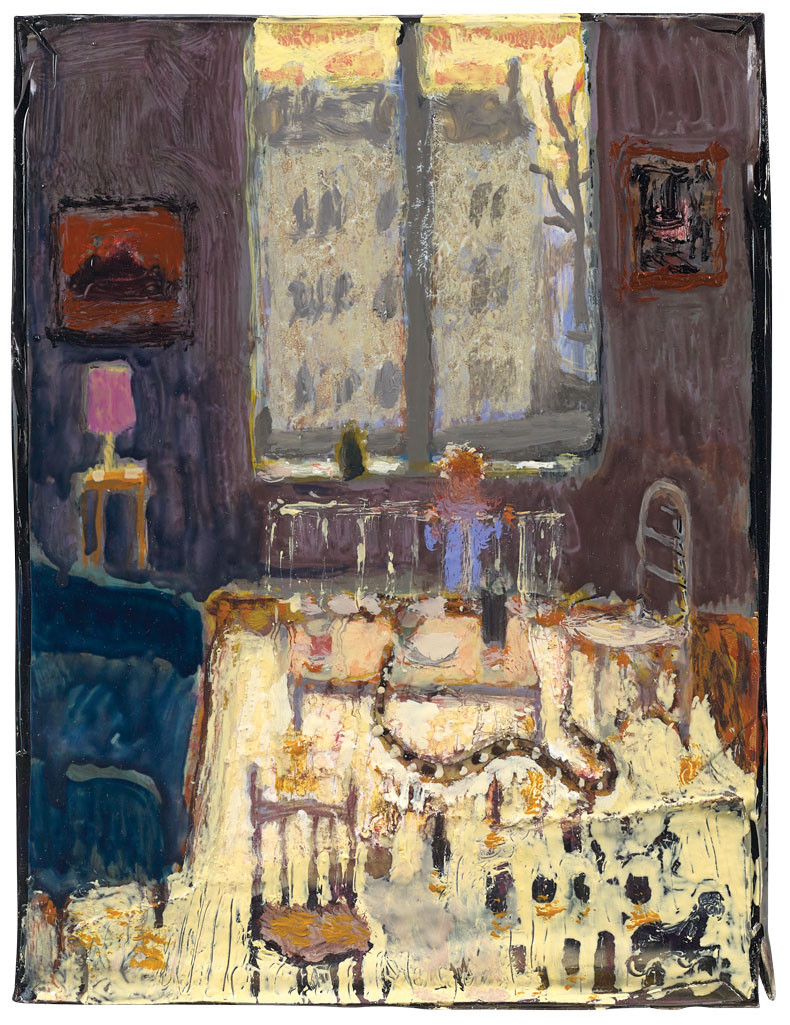
Metaphorical snakes lead us to D.H. Lawrence, whose animal poems Cranston admires. Lawrence has ‘a kind of sympathy but a completely unsentimental sympathy,’ Cranston finds: ‘He acknowledges his almost territorial defensiveness against animals.’ It makes sense that someone who is interested in how things relate to one another should admire a writer who looks at animals from a distance, but there is a technical flourish in Lawrence’s poems that also seems aligned with Cranston’s work. Cranston describes Lawrence’s poems as ‘amazing things […] almost thinking aloud, you know, they feel unedited.’ That sense of naturalness, of pinning down thoughts, seems analogous to the way Cranston paints.
Walled garden (after Paul Klee) (2023), Andrew Cranston. Private collection. Courtesy Andrew Cranston and Ingleby, Edinburgh; © the artist

The paintings often start in the centre of the canvas and grow from there. In Walled garden (after Paul Klee) (2023) there is even a section where you can see a patch of canvas covering up something that had gone before. The canvases are also records of a mind changing, of thinking not aloud but in plain sight. ‘There’s a lot about collage or even the mentality of collage’ that interests him, he says. He doesn’t mean merely layering things up: ‘In a way it becomes a way to rupture the reading of a picture.’ ‘Never a joiner’ as a title for his work takes on other meanings: he doesn’t quite hide the joints of his works. It might be tempting to mistake the works for easy paintings but he bursts that easy way of looking at them by registering how they were wrought – never a joiner but full of joints – or is that disruptions?
Yet when he talks about actually painting he makes it sound like a smoother, and riskier, proposition: ‘It’s tricky with paintings, when they become a very delicate operation and you’re kind of coaxing the thing along – it’s one false move and you’ve wrecked it.’ The way to combat this threat is through vigilance. ‘You’re sometimes looking for the nature of the work, which does seem separate from you, bringing out its character. Other times you get into additions and taking in when they become part of the work, so it’s almost like anything you do can be redeemed.’
When Cranston talks, there is something very soft and relaxed about the way he speaks so it’s surprising to listen back to the conversation and hear how demanding the act of painting is. Being a painter has ‘an element of absurdity’ – not the glib absurdity of contemporary speech, but the loaded absurdity of Samuel Beckett. For Cranston, Beckett’s plays have a ‘kind of humour and bleakness that chimes with me’. It’s an absurdity that reaches its zenith in being an artist, ‘locked in this kind of circular activity, a prisoner – a happy prisoner usually – but you somehow never quite resolve anything or end anything. It’s amazingly infuriating.’ Cranston says this without sounding the slightest bit infuriated. ‘I was quite interested to read Beckett was a keen golfer,’ he says. ‘I like golf as well, it’s got a similar maddening sensation.’
Book-cover works in the studio, including a painting of Cranston’s nephew in front of Dolly the sheep. Photo: Matthew Arthur Williams
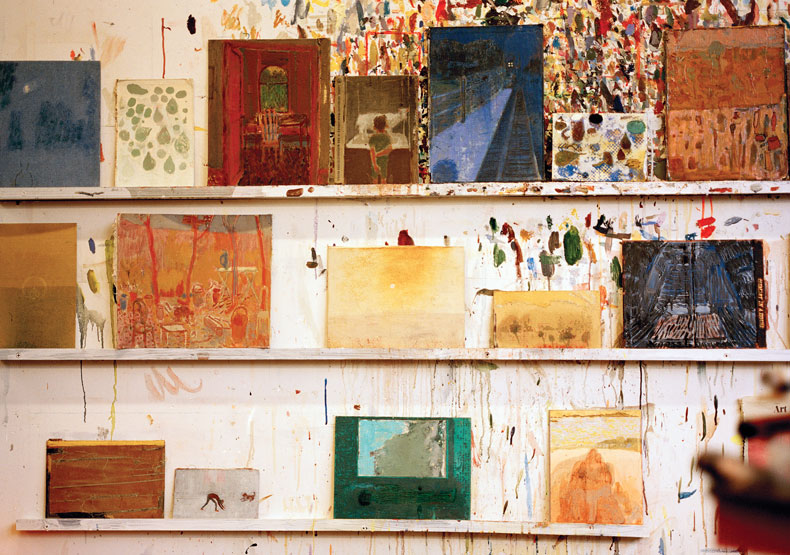
While he might describe painting as an act of maddeningly going around in circles, he interrupts the cyclical nature by introducing new techniques. Some details of his practice sound like the restrictions a poet might impose on a verse, such as using a hard brush to paint sections of a work – ‘I think it is something to do with the colour still remaining on the brush and when you go to another colour, some of that [previous] colour is still there and I think it just sort of connects bits of the painting.’ Recently, Cranston has washed a canvas in a washing machine with dye and painted on it with bleach to allow the world he is depicting to come out of the ground. ‘I think you have to almost constantly be slightly changing [what you do], slightly adapting it all the time,’ he says.
He finds that his work ‘is constantly in dialogue with someone’. It might be a canonical artist such as Titian or Velázquez, who populated Hawick’s library in a boxed set of art history books, but it might just as easily be ‘somebody’s work that you don’t know very well but you’ve just sort of absorbed the spirit of it in a kind of way, somebody like Sigmar Polke’. It would be wrong to think this dialogue results in a vast stylistic transformation. According to Cranston, the American photorealist painter Richard Estes has said that ‘he collected work that he couldn’t make, that’s what interested him, making and collect- ing work and looking at paintings with things that you wouldn’t ever think of doing or maybe even be able to do. So there’s always a slightly covetous thing about certain artists that you can just probably never make it as well [as them].’ The thing is, as he says, ‘There’s a weird nonsense about style, as if an artist had any choice in the matter. Something comes out the way it does and then you make something of that, your habits and tics, but, yeah, it doesn’t seem like a choice.’
While Cranston was tidying his studio, he found a work that he thought was lost. It is a painting on a hardcover: a figure of a boy stands in front of Dolly the sheep in the National Museum of Scotland, one arm crossed behind his back. It’s a smaller book cover than many others, so it’s easy to see how it might have fallen behind a stack of boxes, never to be seen again. The image is based on a photograph of Cranston’s nephew, but you might recognise the figure from a more recent work, Questions of travel (2023), in which a boy stands in front of not Dolly the sheep but a model of a ship in the old Glasgow Transport Museum. Both the setting and the size of the work have been translated into something completely different, a different world. Something about this recycling feels particularly pertinent. Here he is, making something out of what he’s got, taking the mess of the everyday and placing it in relation to other bits of messy life until he’s coaxed it into another way of thinking, no matter how uncanny that thinking might be.
‘Andrew Cranston: what made you stop here?’ is at the Hepworth Wakefield, from 25 November to 2 June 2024.
From the November 2023 issue of Apollo. Preview and subscribe here.

